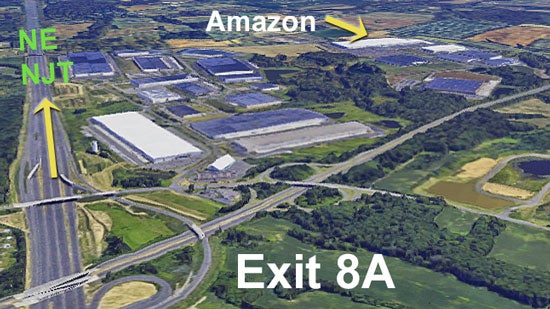Why New Jersey’s warehouse sector is booming
With a bustling retail store in midtown Manhattan and a strong online business as well, B&H Photo Video was beginning to outgrow its Brooklyn fulfillment center and started searching several years ago for new facilities.
The company originally looked to stay in New York, but after checking out locations in New Jersey as well, B&H officials eventually found a home for their new warehouse some 70 miles down the New Jersey Turnpike in Florence, Burlington County.
B&H is now in the midst of making the move out of Brooklyn; its new 500,000 square-foot fulfillment center will employ approximately 300 workers when it opens later this year in an industrial area that already hosts warehouse space for companies like Amazon and Ready Pac. “What we have is a very large facility that allows us to modernize our operation,” company spokesman Michael McKeon said. “We’re very, very happy with the way things worked out in the end.”
The new B&H facility is just one example of how a large sector of the New Jersey economy is becoming reliant on its distribution capabilities, with a burgeoning fulfillment-center industry. Distribution hubs around the country continue to expand in the wake of the Great Recession and the shift to online retailing, but as a recent Moody’s Investors Service report pointed out, New Jersey has a key advantage in its location.
Online shopping driving demand
“New Jersey is within a 24-hour drive of 40 percent of the entire U.S. population,” the Moody’s report said.
In fact, New Jersey’s warehouse industry has been one of the strongest performers in the state’s overall job market as the unemployment rate has dropped to 4.1 percent, which is well below the current national jobless average. Amid recent government investment in infrastructure that benefits the warehouse industry in New Jersey, and a still growing consumer demand for online shopping and other forms of e-commerce, experts say conditions here could stay hot for years.
“All of the indicators that we look at are all so strong right now,” said Noah Balanoff, an executive managing director with Colliers International. “We just don’t see that plateauing or decelerating anytime soon.”
In all, New Jersey’s warehousing and storage subsector had a net gain of an estimated 7,300 jobs between June 2016 and June 2017, according to the latest figures provided by the New Jersey Department of Labor. That equals roughly 11 percent of the total job growth the state has enjoyed since June 2016, according to the figures. And those gains in the warehousing and storage subsector came after a net improvement of roughly 8,500 jobs in the same subsector between June 2006 and June 2016.
Amazon’s big footprint
Contributing in a big way has been Amazon, which in recent years has opened more than five million square feet of warehousing and distribution space in New Jersey, according to the Moody’s report. Amazon’s footprint in the Garden State includes facilities in Carteret, Florence, Logan Township, Robbinsville and Woodbridge, and new Amazon facilities are also opening in Cranbury, Edison and Logan Township.
A big draw for the company, according to Moody’s, is the state’s transportation infrastructure, including the New Jersey Turnpike, as well the Port of Newark-Elizabeth, the second-busiest seaport in North America. Promotional materials prepared by Choose New Jersey, a nonprofit that promotes the state as an economic-development destination, also highlight other infrastructure assets, including Newark Liberty Airport and 1,000 miles of freight-rail tracks.
But it’s been more than just the big fulfillment facilities like those run by Amazon and B&H that have been playing a role in the state’s surging distribution market.
Teaneck-based Key Properties recently announced that it signed a long-term lease with Sky Trading LLC for 11,300 square-feet of warehouse space at 150 Commerce Road in Carlstadt in Bergen County. Sky Trading, which is known for its high-end wigs, hair extensions and other hair pieces, is relocating operations from South Carolina to the Key Properties facility in the Meadowlands.
Sky Trading LLC is relocating operations from South Carolina to this warehouse in Carlstadt in Bergen County.
David Schlussel, a managing member of Key Properties, suggested the demand for warehouse space of all sizes in New Jersey has been influenced to some degree by the e-commerce industry because other types of companies that also require space for warehousing and distribution are competing for some of the same real estate. That’s all combined to create a particularly strong warehouse market in New Jersey right now, he said.
“I would say it’s probably the strongest I’ve seen it I guess in the last 30 years,” Schlussel said.
Sweet spot: Between NYC and Phila
The facility that Sky Trading is moving into also has a prime location — just 30 minutes from New York City and from Port Newark-Elizabeth. It’s also close to routes 3 and 17, and interstates 95 and 80 and the Garden State Parkway, which is important for both getting products in and out of the facility, but also for the workers in the area who will travel to and from the warehouse. So, the old real-estate adage “location, location, location” definitely still applies to New Jersey’s warehouse market. “I think what we’re finding — probably not a terribly big surprise — still the primary and most important aspect is location,” Schlussel said.
Credit: Wikipedia
The area around Exit 8A off the New Jersey Turnpike in Middlesex County has become internationally known as a prime location for warehouses.
Other prime locations for warehouses in New Jersey are along the turnpike itself, with Exit 8A in Middlesex County having become internationally known in the industry. Balanoff said some warehouse rents in the 8A area have increased 30 percent or more in recent years. “It’s essentially back to the basics of supply and demand,” he said. “If you’re an owner (of a warehouse) right now, you’re in a pretty good place.”

Along with the tailwinds of a growing national shift from in-person shopping to e-commerce, the state itself has also tried to support the distribution sector through the Department of Labor’s Career Connections program. The program’s Transportation, Logistics and Distribution Talent Network has used higher-education resources like the New Jersey Institute of Technology and Essex County College to help grow the number of residents who have the training and credentials the industry is looking for.
Infrastructure upgrades, like lifting the Bayonne Bridge (shown in progress) to let the largest cargo ships reach Port Newark-Elizabeth, are a boon for the warehouse industry.
Gov. Chris Christie has also personally highlighted recent infrastructure investments, including the Port Authority of New York and New Jersey’s completion of a lifting of the Bayonne Bridge. That $1.6 billion project increased bridge clearance to 215 feet, which now allows the largest class of cargo ships in the world to make it into Port Newark-Elizabeth. “As a result, more businesses will seek to locate in the port area to create jobs, especially in the skilled trades while garnering the benefits being close to the port can bring,” Christie said during an early May news conference.
Christie and other state officials have also been touting last year’s eight-year, $16 billion reauthorization of the state Transportation Trust Fund as an economic-development initiative. The TTF reauthorization, which also draws federal matching dollars, is already being used to improve key highway and mass-transit infrastructure that is important for the logistics industry.
A recent independent evaluation of the New Jersey economy issued by international management consultant McKinsey & Company recommended that the state continue to focus its energies on supporting several key industries, including the logistics sector. New Jersey could become a key hub for tech-driven logistics as things like robotics, drones and driverless vehicles become more prevalent, the McKinsey report said.
Low paying jobs
A recent report released by the nonpartisan Fund for New Jersey raised concerns about the wage levels of new jobs that are being created in high-cost New Jersey compared to those that were lost to the Great Recession.
According to the state’s latest data, average annual wages in the warehousing and storage subsector in New Jersey in 2015 were just under $50,000. Those wages fall short of the state’s median household income of $72,000, but they’re also much better than the roughly $17,500 average annual pay of a minimum wage worker in New Jersey. They also outpace the national average wage for the warehousing and storage industry, which is about $43,000, according to the federal Bureau of Labor Statistics.
McKeon, the spokesman for B&H, said his company will pay hourly wages above New Jersey’s $8.44 minimum wage. In fact, some experienced warehouse workers at its Brooklyn facilities have made roughly $14 an hour. But the facility will also need other types of skilled employees on-site, including managers.
He also stressed that the company was not lured into New Jersey with any economic tax incentives, something that Amazon has taken advantage of in places like Robbinsville, where it was able to reach terms with local officials on a 20-year payment-in-lieu-of-taxes (PILOT) agreement.
Instead, McKeon said it was the draw of the large facility and its location, which will enable the company to shuttle three or four trucks daily between the warehouse and the retail location on 34th Street in Manhattan. He also cited the cooperation and welcoming attitude of local officials as playing an important role in luring the company to New Jersey.
“I think it’s going to be a good move for us,” he said. “We’re looking forward to it.”
_______________________________________________
NJ Spotlight, an independent online news service on issues critical to New Jersey, makes its in-depth reporting available to NewsWorks.
WHYY is your source for fact-based, in-depth journalism and information. As a nonprofit organization, we rely on financial support from readers like you. Please give today.




